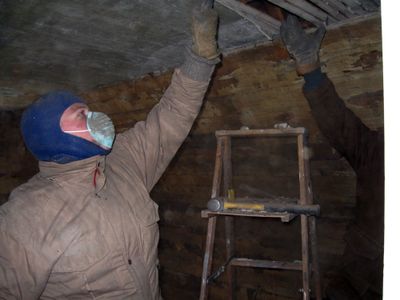House yields regional history
Volunteers helping renovation effort

The windows were open on a cold and blustery Saturday morning to help the coal dust escape, but the volunteers inside the Sterling-Moorman House, 304 Second St., were happily getting their hands and faces dirty, helping with some light demolition and finding small treasures behind years worth of wallpaper and paint.
About eight volunteers came to the house that is being renovated to become a branch of the Cheney Museum. It was built around 1883 by local cabinetmaker Frank Sterling.
The symmetrical lines and pointed windows indicate the home’s Gothic Revival style – it’s the only example in Cheney.
“I thought it might have been a parsonage,” said Scott Wilbanks, a member of the Cheney Historic Preservation Commission.
It was a working-class family home, with just 1,200 square feet and 900 of those on the first floor. The small bedrooms have low, slanted ceilings and about enough room for a bed. The doorknobs are low.
Wilbanks and Charlie Mutschler, another member of the commission, spent some time Saturday discussing the window that faces the front porch of the house. The top portion of the window was likely installed when the home was built.
“It’s beautiful leaded glass,” Mutschler said.
The lower half of the window was probably installed during the 1950s.
Wilbanks and Mutschler found sheets of the old Northwest Tribune from 1882 under paint and wallpaper. Newspapers were often used to insulate buildings at the time the home was built. The two men showed off the newspapers to Bettye Hull, chairwoman of the commission, and Susan Beeman, another member. The four read old advertisements and stories, recognizing names of historical members of the community.
The volunteers wore masks for protection from coal dust in the chimneys. Their hands and faces were smudged with the dust, but they couldn’t have been happier to find little bits of Cheney history.
Beeman said they could have hired contractors for the work, but contractors wouldn’t have had as much fun discovering old newspapers.
The commission is in the running for an $87,000 state grant to help with the project.
“It’s really a very well-preserved example of this kind of building,” Mutschler said.